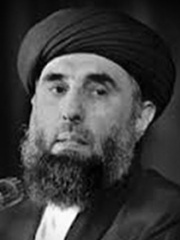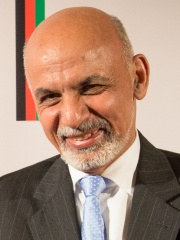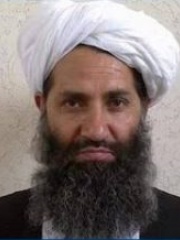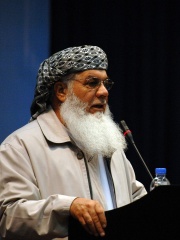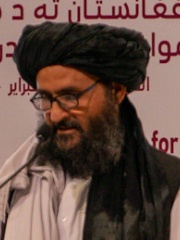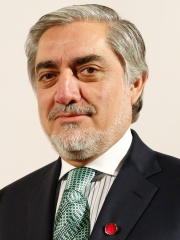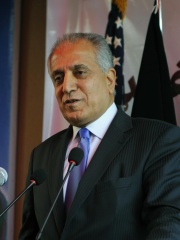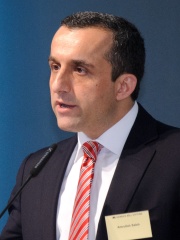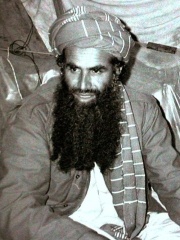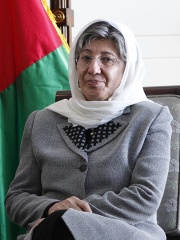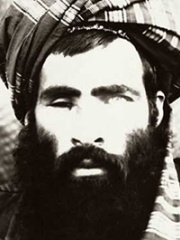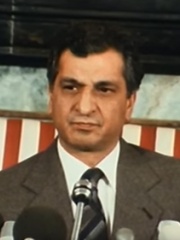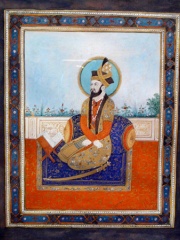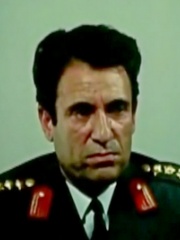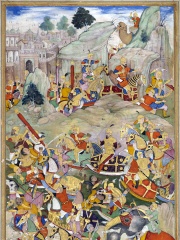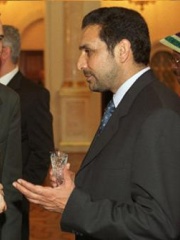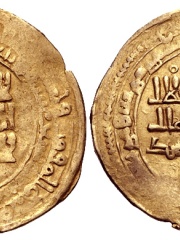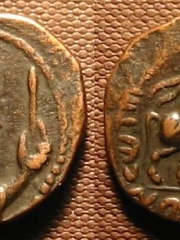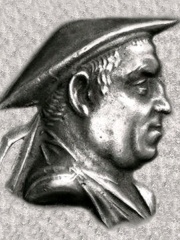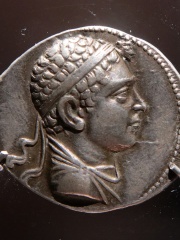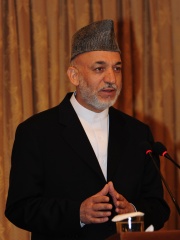
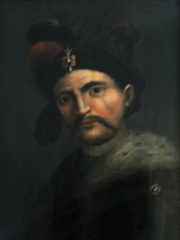
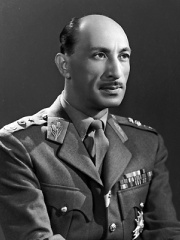
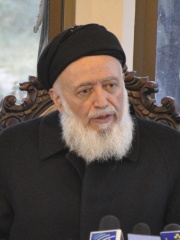
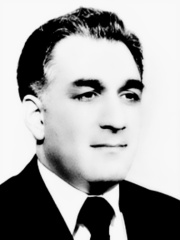
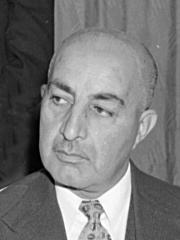
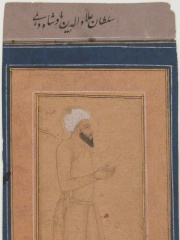

The Most Famous
POLITICIANS from Afghanistan
This page contains a list of the greatest Afghan Politicians. The pantheon dataset contains 15,577 Politicians, 96 of which were born in Afghanistan. This makes Afghanistan the birth place of the 34th most number of Politicians behind Switzerland and Finland.
Top 10
The following people are considered by Pantheon to be the top 10 most legendary Afghan Politicians of all time. This list of famous Afghan Politicians is sorted by HPI (Historical Popularity Index), a metric that aggregates information on a biography’s online popularity. Visit the rankings page to view the entire list of Afghan Politicians.

1. Hamid Karzai (1957 - )
With an HPI of 76.22, Hamid Karzai is the most famous Afghan Politician. His biography has been translated into 88 different languages on wikipedia.
Hamid Karzai (; Pashto/Persian: حامد کرزی, Pashto pronunciation: [ˈhɑmɪd karˈzai], Dari pronunciation: [ˈhɒːmɪd kaɾzeˈiː]; born 24 December 1957) is an Afghan politician who served as the fourth president of Afghanistan from July 2002 to September 2014, including as the first elected president of the Islamic Republic of Afghanistan from December 2004 to September 2014. He previously served as Chairman of the Afghan Interim Administration from December 2001 to July 2002. He is the chief (khān) of the Popalzai Durrani tribe of Pashtuns in Kandahar Province. Born in Kandahar, Karzai graduated from Habibia High School in Kabul and later received a master's degree in India in the 1980s. He moved to Pakistan where he was active as a fundraiser for the Afghan rebels during the Soviet–Afghan War (1979–1989) and its aftermath. He briefly served as Deputy Foreign Minister in the Islamic State of Afghanistan government. In July 1999, Karzai's father was assassinated and Karzai succeeded him as head of the Popalzai tribe. In October 2001 the United States invasion of Afghanistan began and Karzai led the Pashtun tribes in and around Kandahar in an uprising against the Taliban; he became a dominant political figure after the removal of the Taliban regime in late 2001. During the December 2001 International Conference on Afghanistan in Germany, Karzai was selected by prominent Afghan political figures to serve a six-month term as chairman of the Interim Administration. He was then chosen for a two-year term as interim president during the 2002 loya jirga (grand assembly) that was held in Kabul, Afghanistan. After the 2004 presidential election, Karzai was declared the winner and became President of Afghanistan. He won a second five-year term in the 2009 presidential election; this term ended in September 2014, and he was succeeded by Ashraf Ghani. During his presidency, Karzai was known in the international community for being an alliance builder between Afghanistan's communities. In later years, his relationship with NATO and the United States became increasingly strained, and he has been accused several times of corruption. He called the Taliban his brothers and warned that the heavy-handed counterinsurgency in Afghanistan would only revive the Taliban insurgency against the former Afghan government, urging the US to instead focus on bringing Pakistan's support for the Taliban leadership to heel, but the US largely ignored his requests. After the Taliban takeover of Kabul in 2021, Karzai stated the Taliban did not capture the city by force, but rather were invited by him in order to prevent chaos. He said that in order to gain international recognition, the new Taliban government needed internal legitimacy, which could be achieved through a general election or loya jirga.

2. Abbas the Great (1571 - 1629)
With an HPI of 75.49, Abbas the Great is the 2nd most famous Afghan Politician. His biography has been translated into 69 different languages.
Abbas I (Persian: عباس یکم, romanized: ʿAbbās; 27 January 1571 – 19 January 1629), commonly known as Abbas the Great (Persian: عباس بزرگ, romanized: ʿAbbās-e Bozorg), was the fifth shah of Safavid Iran from 1588 to 1629. The third son of Shah Mohammad Khodabanda, he is generally considered one of the greatest rulers of Iranian history and the Safavid dynasty. Although Abbas would preside over the apex of Safavid Iran's military, political and economic power, he came to the throne during a troubled time for the country. Under the ineffective rule of his father, the country was riven with discord between the different factions of the Qizilbash army, who killed Abbas' mother and elder brother. Meanwhile, Iran's enemies, the Ottoman Empire (its archrival) and the Uzbeks, exploited this political chaos to seize territory for themselves. In 1588, one of the Qizilbash leaders, Murshid Qoli Khan, overthrew Shah Mohammed in a coup and placed the 16-year-old Abbas on the throne. However, Abbas soon seized power for himself. Under his leadership, Iran developed the ghilman system where thousands of Circassian, Georgian, and Armenian slave-soldiers joined the civil administration and the military. With the help of these newly created layers in Iranian society (initiated by his predecessors but significantly expanded during his rule), Abbas managed to eclipse the power of the Qizilbash in the civil administration, the royal house, and the military. These actions, as well as his reforms of the Iranian army, enabled him to fight the Ottomans and Uzbeks and reconquer Iran's lost provinces, including Kakheti whose people he subjected to widescale massacres and deportations. By the end of the 1603–1618 Ottoman War, Abbas had regained possession over Transcaucasia and Dagestan, as well as swaths of Eastern Anatolia and Mesopotamia. He also took back land from the Portuguese and the Mughals and expanded Iranian rule and influence in the North Caucasus, beyond the traditional territories of Dagestan. Abbas was a great builder and moved his kingdom's capital from Qazvin to Isfahan, making the city the pinnacle of Safavid architecture. In his later years, following a court intrigue involving several leading Circassians, Abbas became suspicious of his own sons and had them killed or blinded.

3. Mohammed Zahir Shah (1914 - 2007)
With an HPI of 72.54, Mohammed Zahir Shah is the 3rd most famous Afghan Politician. His biography has been translated into 62 different languages.
Mohammad Zahir Shah (Pashto/Dari: محمد ظاهر شاه; 15 October 1914 – 23 July 2007) was the last King of Afghanistan, reigning from 8 November 1933 until he was deposed on 17 July 1973. Ruling for 40 years, Zahir Shah was the longest-serving ruler of Afghanistan since the foundation of the Durrani Empire in the 18th century. He expanded Afghanistan's diplomatic relations with many countries, including with both sides of the Cold War. In the 1950s, Zahir Shah began modernizing the country, culminating in the creation of a new constitution and a constitutional monarchy system. Demonstrating nonpartisanism, his long reign was marked by peace in the country which was lost afterwards with the onset of the Afghan conflict. In 1973, while Zahir Shah was undergoing medical treatment in Italy, his regime was overthrown in a coup d'état by his cousin and former prime minister, Mohammad Daoud Khan, who established a single-party republic, ending more than 225 years of continuous monarchical government. He remained in exile near Rome until 2002, returning to Afghanistan after the end of the Taliban government. He was given the title Father of the Nation, which he held until his death in 2007.

4. Burhanuddin Rabbani (1940 - 2011)
With an HPI of 71.27, Burhanuddin Rabbani is the 4th most famous Afghan Politician. His biography has been translated into 53 different languages.
Burhānuddīn Rabbānī (Persian: برهانالدین ربانی; 20 September 1940 – 20 September 2011) was an Afghan politician and teacher who served as President of Afghanistan from 1992 to 1996, and again from November to December 2001 (in exile from 1996 to 2001). Born in the Badakhshan Province, Rabbani studied at Kabul University and worked there as a professor of Islamic theology. He formed the Jamiat-e Islami (Islamic Society) at the university which attracted then-students Gulbuddin Hekmatyar and Ahmad Shah Massoud, both of whom would eventually become the two leading commanders of the Afghan mujahideen in the Soviet–Afghan War from 1979. Rabbani was chosen to be the President of Afghanistan after the end of the former communist regime in 1992. Rabbani and his Islamic State of Afghanistan government was later forced into exile by the Taliban, and he then served as the political head of the Northern Alliance, an alliance of various political groups who fought against the Taliban regime in Afghanistan. During his time in the office, there were a lot of internal clashes between different fighting groups. After the Taliban government was toppled during Operation Enduring Freedom, Rabbani returned to Kabul and served briefly as President from 13 November to 22 December 2001, when Hamid Karzai was chosen as his succeeding interim leader at the Bonn International Conference. In later years he became head of Afghanistan National Front (known in the media as United National Front), the largest political opposition to Karzai's government. On 20 September 2011, Rabbani was assassinated by a suicide bomber entering his home in Kabul. As suggested by the Afghan parliament, Afghanistan's President Hamid Karzai gave him the title of "Martyr of Peace". His son Salahuddin Rabbani was chosen in April 2012 to lead efforts to forge peace in Afghanistan with the Taliban.

5. Ahmad Shah Massoud (1953 - 2001)
With an HPI of 70.22, Ahmad Shah Massoud is the 5th most famous Afghan Politician. His biography has been translated into 64 different languages.
Ahmad Shah Massoud (Dari/Pashto: احمد شاه مسعود, Persian pronunciation: [ʔæhmæd ʃɒːh mæsʔuːd]; September 2, 1953 – September 9, 2001) was an Afghan politician and military commander. He was a powerful guerrilla commander during the resistance against the Soviet occupation between 1979 and 1989. In the 1990s, he led the government's military wing against rival militias; after the Taliban takeover, he was the leading opposition commander against their regime until his assassination in 2001. Massoud came from an ethnic Tajik, Sunni Muslim background in the Panjshir Valley of Northern Afghanistan. He began studying engineering at Polytechnical University of Kabul in the 1970s, where he became involved with religious anti-communist movements around Burhanuddin Rabbani, a leading Islamist. He participated in a failed uprising against Mohammed Daoud Khan's government. He later joined Rabbani's Jamiat-e Islami party. During the Soviet–Afghan War, his role as a powerful insurgent leader of the Afghan mujahideen earned him the nickname "Lion of Panjshir" (شیر پنجشیر) among his followers. Supported by Britain's MI6 and to a lesser extent by the U.S. Central Intelligence Agency (CIA), he successfully resisted the Soviets from taking the Panjshir Valley. In 1992, he signed the Peshawar Accord, a peace and power-sharing agreement, in the post-communist Islamic State of Afghanistan. He was appointed the Minister of Defense as well as the government's main military commander. His militia fought to defend Kabul against militias led by Gulbuddin Hekmatyar and other warlords who were bombing the city, as well as later against the Taliban, who laid siege to the capital in January 1995 after the city had seen fierce fighting with at least 60,000 civilians killed. Following the rise of the Taliban in 1996, Massoud, who rejected the Taliban's fundamentalist interpretation of Islam, returned to armed opposition until he was forced to flee to Kulob, Tajikistan, strategically destroying the Salang Tunnel on his way north. He became the military and political leader of the United Islamic Front for the Salvation of Afghanistan or Northern Alliance, which by 2000 controlled only between 5 and 10 percent of the country. In 2001 he visited Europe and urged European Parliament leaders to pressure Pakistan on its support for the Taliban. He also asked for humanitarian aid to combat the Afghan people's gruesome conditions under the Taliban. On September 9, 2001, Massoud was injured in a suicide bombing by two al-Qaeda assassins, ordered personally by the al-Qaeda leader Osama bin Laden himself; he lost his life while en route to a hospital across the border in Tajikistan. Two days later, the September 11 attacks occurred in the United States, which ultimately led to the North Atlantic Treaty Organization invading Afghanistan and allying with Massoud's forces. The Northern Alliance eventually won the two-month-long war in December 2001, removing the Taliban from power. Massoud has been described as one of the greatest guerrilla leaders of the 20th century and has been compared to Josip Broz Tito, Ho Chi Minh and Che Guevara. Massoud was posthumously named "National Hero" by the order of President Hamid Karzai after the Taliban were ousted from power. The date of Massoud's death, September 9, was observed as a national holiday known as "Massoud Day" until the Taliban takeover in August 2021. His followers call him Amer Sāhib-e Shahīd (آمر صاحب شهید), which translates to "(our) martyred commander". He has been posthumously honored by a plaque in France in 2021, and in the same year was awarded with the highest honor of Tajikistan.

6. Hafizullah Amin (1929 - 1979)
With an HPI of 69.93, Hafizullah Amin is the 6th most famous Afghan Politician. His biography has been translated into 44 different languages.
Hafizullah Amin (Pashto: حفيظ الله امين; 1 August 1929 – 27 December 1979) was an Afghan communist head of state, who served from September 1979 until his assassination. He organized the Saur Revolution of 1978 and co-founded the Democratic Republic of Afghanistan (DRA), ruling Afghanistan as General Secretary of the People's Democratic Party. Born in the town of Paghman in Kabul Province, Amin studied at Kabul University and started his career as a teacher before he twice went to the United States to study. During this time, Amin became attracted to Marxism and became involved in radical student movements at the University of Wisconsin. Upon his return to Afghanistan, he used his teaching position to spread socialist ideologies to students, and he later joined the People's Democratic Party of Afghanistan (PDPA), a new far-left organization co-founded by Nur Muhammad Taraki and Babrak Karmal. He ran as a candidate in the 1965 parliamentary election but failed to secure a seat, but in 1969 became the only Khalqist elected to parliament, increasing his standing within the party. Amin was the main organizer of the April 1978 Saur Revolution, which overthrew the government of Mohammad Daoud Khan and formed a pro-Soviet state based on socialist ideals. Being second in chief of the Democratic Republic, Amin soon became the regime's strongman, the main architect of the state's programs including mass persecution of those deemed counter-revolutionary. A growing personal struggle with General Secretary Taraki eventually led to Amin wrestling power away then successfully deposing him and later ordering his execution; on 16 September 1979, Amin named himself Chairman of the Council of Ministers (head of government), Chairman of the Revolutionary Council (head of state), and General Secretary of the PDPA Central Committee (supreme leader). Amin's short-lived leadership featured controversies from beginning to end. His government failed to solve the problem of the population revolting against the regime as the situation rapidly worsened and army desertions and defections continued. He tried to change things with friendly overtures to the United States, however his reputation in Washington was tarnished by his role in the assassination of Adolph Dubs. Some Afghans, especially those from minority ethnic groups such as the Hazaras, held Amin responsible for the regime's harshest measures, such as ordering thousands of executions, more than 7,000 of which were from the Hazara minority. Thousands of people disappeared without trace during his time in office. The Soviet Union under Leonid Brezhnev was dissatisfied with and mistrusted Amin; they intervened in Afghanistan, invoking the 1978 Twenty-Year Treaty of Friendship between Afghanistan and the Soviet Union. Soviet operatives assassinated Amin at the Tajbeg Palace on 27 December 1979 as part of Operation Storm-333, kickstarting the 10-year Soviet–Afghan War; he had ruled for a little more than three months.

7. Mohammed Daoud Khan (1909 - 1978)
With an HPI of 69.56, Mohammed Daoud Khan is the 7th most famous Afghan Politician. His biography has been translated into 46 different languages.
Mohammad Daoud Khan (Pashto: محمد داود خان), also romanized as Daud Khan or Dawood Khan (18 July 1909 – 28 April 1978), was an Afghan politician who served as prime minister of Afghanistan from 1953 to 1963 and, as leader of the 1973 Afghan coup d'état which overthrew the monarchy, served as the first president of Afghanistan from 1973 until his assassination in the Saur Revolution. Born into the Afghan royal family and addressed by the prefix "Sardar", Khan started as a provincial governor and later a military commander before being appointed as Prime Minister by his cousin, King Mohammad Zahir Shah, serving for a decade. Having failed to persuade the King to implement a one-party system, Khan bloodlessly overthrew the monarchy with the backing of Afghan Army officers, and proclaimed himself the first President of the Republic of Afghanistan, establishing an autocratic one-party system under his National Revolutionary Party. Khan was known for his autocratic rule, and for his educational and progressive social reforms. Under his regime, he headed a purge of communists in the government, and many of his policies also displeased religious conservatives and liberals who were in favor of restoring the multiparty system that existed under the monarchy. Social and economic reforms implemented under his ruling were successful, but his foreign policy led to tense relations with neighboring countries. In 1978, he was deposed and assassinated during the 1978 Afghan coup d'état, led by the Afghan military and the communist People's Democratic Party of Afghanistan (PDPA). His body was discovered 30 years later and was identified by a small golden Quran gifted by King Khalid of Saudi Arabia he always carried. He received a state funeral.

8. Alauddin Khalji (1266 - 1316)
With an HPI of 69.50, Alauddin Khalji is the 8th most famous Afghan Politician. His biography has been translated into 36 different languages.
Alauddin Khalji (Persian: علاء الدین خلجی; r. 1296–1316), born Ali Gurshasp, was a ruler from the Khalji dynasty that ruled the Delhi Sultanate in the Indian subcontinent. Alauddin instituted a number of significant administrative changes, related to revenues, price controls, and society. He also successfully fended off several Mongol invasions of India. Alauddin was a nephew and a son-in-law of his predecessor Jalaluddin. When Jalaluddin became the Sultan of Delhi after deposing the Mamluks, Alauddin was given the position of Amir-i-Tuzuk (equivalent to master of ceremonies). After suppressing a revolt against Jalaluddin, Alauddin obtained the governorship of Kara in 1291, and the governorship of Awadh in 1296, after a profitable raid on Bhilsa. In 1296, Alauddin raided Devagiri, and acquired loot to stage a successful revolt against Jalaluddin. After killing Jalaluddin, he consolidated his power in Delhi, and subjugated Jalaluddin's sons in Multan. Over the next few years, Alauddin successfully fended off the Mongol invasions from the Chagatai Khanate, at Jaran-Manjur (1297–1298), Sivistan (1298), Kili (1299), Delhi (1303), and Amroha (1305). In 1306, his forces achieved a decisive victory against the Mongols near the Ravi riverbank, and later ransacked the Mongol territories in present-day Afghanistan. The military commanders that successfully led his army against the Mongols include Zafar Khan, Ulugh Khan, and his slave-general Malik Kafur. Alauddin conquered the kingdoms of Gujarat (raided in 1299 and annexed in 1304), Jaisalmer (1299), Ranthambore (1301), Chittor (1303), Malwa (1305), Siwana (1308), and Jalore (1311). These victories ended several Rajput and other Hindu dynasties, including the Paramaras, the Vaghelas, the Chahamanas of Ranastambhapura and Jalore, the Rawal branch of the Guhilas, and possibly the Yajvapalas. His slave-general Malik Kafur led multiple campaigns to the south of the Vindhyas, obtaining a considerable amount of wealth from Devagiri (1308), Warangal (1310) and Dwarasamudra (1311). These victories forced the Yadava king Ramachandra, the Kakatiya king Prataparudra, and the Hoysala king Ballala III to become Alauddin's tributaries. Kafur also raided the Pandya kingdom (1311), obtaining much treasure, elephants, and horses. During the last years of his life, Alauddin had an illness and relied on Malik Kafur to handle the administration. After his death in 1316, Malik Kafur appointed Shihabuddin, son of Alauddin and his Hindu wife Jhatyapali, as a puppet monarch. His elder son Qutbuddin Mubarak Shah seized the power shortly after his death.

9. Amanullah Khan (1892 - 1960)
With an HPI of 68.57, Amanullah Khan is the 9th most famous Afghan Politician. His biography has been translated into 50 different languages.
Ghazi Amanullah Khan (Pashto and Persian: غازی امان الله خان; 1 June 1892 – 26 April 1960) was the sovereign of Afghanistan from 1919, first as Emir and after 1926 as King, until his abdication in 1929. After the end of the Third Anglo-Afghan War in August 1919, Afghanistan was able to relinquish its protected state status to proclaim independence and pursue an independent foreign policy free from the influence of the United Kingdom. His rule was marked by dramatic political and social change, including attempts to modernise Afghanistan along Western lines. He did not fully succeed in achieving this objective due to an uprising by Habibullah Kalakani and his followers. On 14 January 1929, Amanullah abdicated and fled to neighbouring British India as the Afghan Civil War began to escalate. From British India, he went to Europe, where after 30 years in exile, he died in Zürich, Switzerland on 26 April 1960. His body was brought to Afghanistan and buried in Jalalabad near his father Habibullah Khan's tomb.
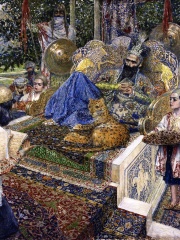
10. Mahmud of Ghazni (971 - 1030)
With an HPI of 68.14, Mahmud of Ghazni is the 10th most famous Afghan Politician. His biography has been translated into 58 different languages.
Abu al-Qasim Mahmud ibn Sabuktigin (Persian: ابوالقاسم محمود بن سبکتگین, romanized: Abu al-Qāṣim Maḥmūd ibn Sabuktigīn; 2 November 971 – 30 April 1030), usually known as Mahmud of Ghazni or Mahmud Ghaznavi (محمود غزنوی), was Sultan of the Ghaznavid Empire, ruling from 998 to 1030. During his reign and in medieval sources, he is usually known by his honorific Yamin al-Dawla (یمین الدوله, lit. 'Right Hand of the State'). At the time of his death, his kingdom had been transformed into an extensive military empire, which extended from northwestern Iran proper to the Punjab in the Indian subcontinent, Khwarazm in Transoxiana, and Makran. Highly Persianized, Mahmud continued the bureaucratic, political, and cultural customs of his predecessors, the Samanids. He established the ground for a future Persianate state in Punjab, particularly centered on Lahore, a city he conquered. His capital of Ghazni evolved into a significant cultural, commercial, and intellectual centre in the Islamic world, almost rivalling the important city of Baghdad. The capital appealed to many prominent figures, such as al-Biruni and Ferdowsi. Mahmud ascended the throne at the age of 27 upon his father's death, albeit after a brief war of succession with his brother Ismail. He was the first ruler to hold the title Sultan ("authority"), signifying the extent of his power while at the same time preserving an ideological link to the suzerainty of the Abbasid Caliphs. During his rule, he invaded and plundered the richest cities and temple towns, such as Mathura and Somnath in medieval India seventeen times, and used the booty to build his capital in Ghazni.
Pantheon has 95 people classified as politicians born between 327 BC and 1992. Of these 95, 24 (25.26%) of them are still alive today. The most famous living politicians include Hamid Karzai, Gulbuddin Hekmatyar, and Abdul Rashid Dostum. The most famous deceased politicians include Abbas the Great, Mohammed Zahir Shah, and Burhanuddin Rabbani. As of April 2022, 23 new politicians have been added to Pantheon including Amrullah Saleh, Abdul Rasul Sayyaf, and Abdul Qadir.
Living Politicians
Go to all Rankings
Hamid Karzai
1957 - Present
HPI: 76.22
Gulbuddin Hekmatyar
1949 - Present
HPI: 65.73
Abdul Rashid Dostum
1954 - Present
HPI: 64.76
Ashraf Ghani
1949 - Present
HPI: 62.48
Hibatullah Akhundzada
1961 - Present
HPI: 60.71
Ismail Khan
1946 - Present
HPI: 56.46
Abdul Ghani Baradar
1968 - Present
HPI: 55.85
Abdullah Abdullah
1960 - Present
HPI: 55.42
Zalmay Khalilzad
1951 - Present
HPI: 52.30
Amrullah Saleh
1972 - Present
HPI: 51.11
Abdul Rasul Sayyaf
1946 - Present
HPI: 49.25
Sima Samar
1957 - Present
HPI: 48.20

Deceased Politicians
Go to all Rankings
Abbas the Great
1571 - 1629
HPI: 75.49
Mohammed Zahir Shah
1914 - 2007
HPI: 72.54
Burhanuddin Rabbani
1940 - 2011
HPI: 71.27
Ahmad Shah Massoud
1953 - 2001
HPI: 70.22
Hafizullah Amin
1929 - 1979
HPI: 69.93
Mohammed Daoud Khan
1909 - 1978
HPI: 69.56
Alauddin Khalji
1266 - 1316
HPI: 69.50
Amanullah Khan
1892 - 1960
HPI: 68.57
Mahmud of Ghazni
971 - 1030
HPI: 68.14
Mohammed Omar
1962 - 2013
HPI: 67.66
Babrak Karmal
1929 - 1996
HPI: 66.82
Humayun
1508 - 1556
HPI: 66.36

Newly Added Politicians (2022)
Go to all Rankings
Amrullah Saleh
1972 - Present
HPI: 51.11
Abdul Rasul Sayyaf
1946 - Present
HPI: 49.25
Abdul Qadir
1944 - 2014
HPI: 48.48
Sultan Ali Keshtmand
1935 - Present
HPI: 47.75
Kamran Mirza
1512 - 1557
HPI: 47.62
Abul-Qasim Babur Mirza
1422 - 1457
HPI: 47.39
Ahmad Zia Massoud
1956 - Present
HPI: 47.01
Muhammad of Ghazni
998 - 1041
HPI: 46.58
Vima Takto
100 - Present
HPI: 46.17
Abdul Aziz Hotak
1700 - 1717
HPI: 46.03
Apollodotus I
300 BC - 200 BC
HPI: 45.68
Euthydemus II
200 BC - 200 BC
HPI: 45.54

Which Politicians were alive at the same time? This visualization shows the lifespans of the 25 most globally memorable Politicians since 1700.

